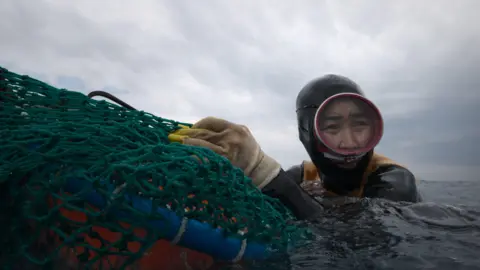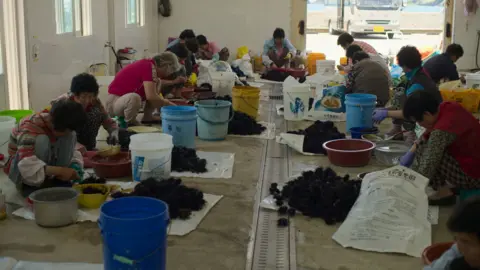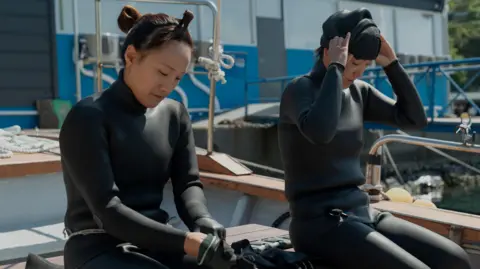Malala: How South Korea's 'Real-Life Mermaid' Made Her Want to Learn to Swim
 apple
apple What if someone told you that mermaids are real?
Forget fish tails, we mean women capable of holding their breath for several minutes while diving under the ocean hundreds of times a day.
These are South Korea's Hyeonyo divers, a community of women from Jeju Island who have been free-diving (without oxygen) to collect seafood for centuries.
Now, with most of them in their 60s, 70s and 80s, their traditions and way of life are at risk as younger women take up the profession and the sea changes potentially beyond recognition.
These events prompted US-Korean filmmaker Su Kim to team up with women's education advocate and Nobel Peace Prize winner Malala Yousafzai to share their story with the world in her film The Last of the Sea Women.
The daughter of Korean immigrants, the American-born Kim first came to Henyeo when she was a child, vacationing in South Korea.
“I was so moved by them for the same reason you see in the film — they were incredibly brave and vibrant and confident. They were so loud… fighting and laughing, and they gave off this great energy and took their place so unapologetically,” Kim said.
“I fell in love with that whole vibe and huge energy when I was a little girl. And so I grew up fascinated by them. They were a version of Korean femininity that I was inspired by and wanted to emulate,” she added.
“I was so shocked that I didn't know about Hanyo, like a lot of people didn't, that I immediately said yes,” explained Malala, who was a producer on the film.
 apple
apple“The story took on an urgency about 10 years ago when I learned that this was probably the last generation of Hanyeow,” Kim explained. “It became an urgent mandate to make sure that someone documented… while we had them and while they could still tell our own stories in their own words.”
The film follows the women as they do their grueling work during the harvest season and examines the challenges they face both in and out of the water.
They go out to dive every morning at 6 am. They hold their breath for several minutes, return to the surface, and return to the bottom again – 100 to 300 times in one session.
Just imagine the fitness levels. They harvest for four hours and then spend another three or four shelling and preparing their catch.
There are various theories as to why women started taking over this traditionally male job so many years ago. Visit the Jeju website It is said that the number of males in the population was low because a large proportion of them died in rough seas while fishing in boats.
As a result, there were not many men to cut the sea, so women gradually took over the job.
'Sad Grandma'
This is the first major documentary about Hanyo and Kim says it was difficult to get access.
“Even the communities, they're very insular,” she explains.
“They are rural people who live in fishing villages. They don't have much contact with Jeju city.”
Kim found a researcher with a history of NGOs and community outreach.
“So this woman… introduced us, then I went down and I basically spent two weeks… with the Henyo community and really gained their trust. And I did it mostly by listening.
“They actually wanted to talk about all the things that happened to them.
“They wanted to talk about the fact that they felt they were on the verge of extinction. They wanted to talk about what was happening to the ocean that no one knew or cared about.”
Kim says she had to reassure the women that she wouldn't stereotype them or pity them for working in old age.
“They love to work! They feel so empowered and empowered.
Kim told them he would show them “true power”.
“'I promise I'm not going to fall into this sad grandma trope because I don't see you that way, I see you as a hero',” he explained to the group.
“After that, we became a family.”
 apple
appleThe risk is great. There is no insurance available for the job, as it is very dangerous. And now the ocean – and women's livelihoods – are under threat
Global warming reduces marine life, especially in shallow waters; Deep diving is more difficult without oxygen.
Most of the film focuses on women's protests Radioactive water from the Fukishima plant in Japan Being released into the sea (Jeju on the Japanese border), one of the Hanyos, soon leads Deok Jang directly to the United Nations Human Rights Council in Geneva.
The message from experts is, overwhelmingly, that the release is safe and has received the green light from the International Atomic Energy Agency – but not all scientists agree on its implications.
When henyeo collects marine life, they are allowed to harvest certain seafood, which helps protect the ecosystem.
Another reason they don't use oxygen tanks is because “they believe that by holding their breath, it allows them to collect the natural amount of marine life that they should be harvesting,” Kim explains, which helps avoid overfishing.
 apple
appleWhile the bigger threat is from within, fewer and fewer women are opting for this tough profession.
A training school was set up in the early 2000s to try to stem the declining numbers but only 5% of those who attend become henyeos.
All is not lost though. The film introduces us to two young women from another island who have found a following on social media and suggest flexible work hours in family life. One of them had to learn to swim at age 30 to work.
Elderly women visit them for festivals and protests – they call them “their children” and are named “Aunties” in return.
Yousafzai is inspired: “When I see Heniyo and how they work together, it just reminds me of the collective work that women are doing everywhere else, including advocating to raise awareness about the systemic oppression that Afghan women face. “
“When a girl watches this documentary, I want her to believe in herself and realize that she can do anything. She can stay under water for two to three minutes without oxygen,” she says. “And of course I still have to. Take some swimming lessons to learn to swim! I'm point blank, but this has inspired me to consider swimming.”
The Last of the Sea Women is available on Apple TV+ from 11 October 2024.


